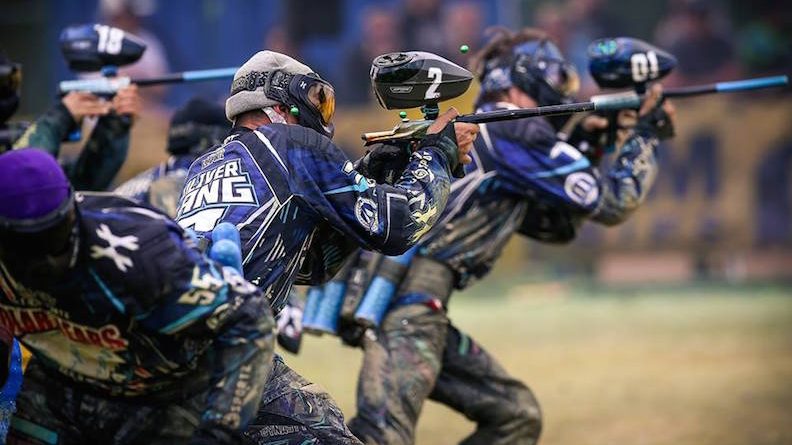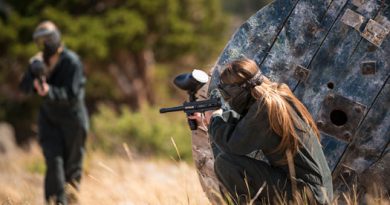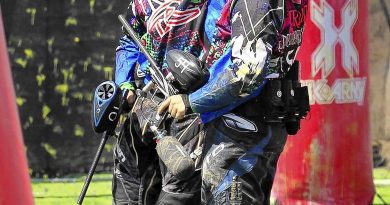Commander Cup Controversy
By Chris DeForge
Dynasty and Stockholm Joy fans are battling over the controversial decision made at the Orange County Commander’s Cup. Referee coach of the event Dan Perez answered simply in an interview that the call was “all in the rulebook, yeah.” The aftermath of the controversy brought about a few important issues to mind, seen in the commentary by Matty Marshal and Chris Lasoya after the game. Marshal and Lasoya may not be the most articulate commentators compared to professionals from conventional sports, but their status as players and members of the tournament scene ensure their words are relevant and not simply cliché statements prepared by some assistant. Both discussed the wrapping up of the 2006 season, the role of overshooting and “malicious intent” in the NPPL (which is perhaps ironic, given Lasoya’s less than impeccable sportsmanship and concern for safety on the field), and of course, the judges.
For those of you who missed out on the frenzy, the latest news on the Commander’s Cup is in reference to the final game between Dynasty and Stockholm Joy. Put simply, five players converged on each other in a frenzied “blood bath” as Marshal describes, sending players to the dead box and the crowd into an uproar. One Joy player had his armband pulled, yet he continued running and shot the Dynasty player. The crowd went wild, players scatted across the field, cameramen were looking for the best shots, and the refs were desperately trying to maintain control and figure out the call. The specifics can be read online on the tons of opinions being posted – but be wary, since everyone seems to be judging the circumstances differently. And this same challenge was presented to the NPPL referees and Judge Perez.*
The plot thickened afterwards when a letter Stockholm Joy wrote to the NPPL was made available on the PBNation webpage. The letter brought up some critical issues to the tournament scene: what is the place of video replay and photo evidence for a call? How does retrospect come into play? How does the wording of certain rules affect their execution?
Perhaps the title of judge is telling. When push comes to shove, the judge decides who wins and who loses in a controversy. Marshal noted that “Brian Cole is pleading his case [to Dan Perez] … everything is on the line right now. If they win, they win the final and the tournament, if not, it’ll go to a one on one or Joy Division takes the second win in a row and XSV wins the title. I would pull every bit of argumentative skills I have if I were Brian…” Whether through Dynasty’s verbal skills or sheer chance, they came through with the win, much to the dismay of Joy fans. And surely this isn’t the first time the interpretation of rules has dramatically affected a professional paintball match. As early as the first ESPN aired World Cup (when Dale Price’s Turtles took a hard hit from the lack of a dead man’s walk provision in the NPPL rulebook) there have been great conflicts.
The problem of officiating or judging a match is that the nature of paintball makes it unlike any other extreme sport. The traits of bias, incorrect angles, forced quick decisions, and emotion are all exaggerated in a sport where people are shooting each other rapidly and at close range. No matter how much “legalese” is written into the rulebook, the judges have the final say. Still, there are a few critical aspects to examine into why paintball refereeing is so difficult, especially on a higher level. Whether player or referee (and frequently in paintball, we are both) a firm understanding of the rules can really make a difference. A glance at the rulebook reveals that some of the logic being touted on both sides of the Joy/Dynasty controversy is flawed.
Eliminated Players – Armband or No Armband?
The attitudes of members of the tournament community constitute one major obstacle. To some players, he or she is not eliminated until an official physically removes his or her armband. The obligation for a paint check as well as an elimination is thus on the official. Others feel that wiping, so long as it is not detected by an official, is an integral part of the game. The NPPL has defined a hit as a player marked by paint from the marker of an active player from either team. The presence of paint on a player when the referee has not seen the paintball’s impact also constitutes as an elimination.
The problem with the Joy scenario is that there are no stipulations on the NPPL rulebook about armbands. When a player is struck by an “obvious hit” that player must immediately stop firing and walk to the dead box. Players are “playing on” when they continue to shoot at other players (18.01i), move somewhere other than toward the dead box (18.01ii), or even engage in conversation with the referees (18.01 iii). While the pulling of an armband constitutes a referee’s decision to eliminate a player, a player can be eliminated before this action: in fact, the player’s elimination is immediately after a hit takes place. This invalidates the argument that certain players were still in the game as their armbands had not been pulled.
Regardless, it needs to be noted that the snake side referee by calling a mutual elimination implied that the first Joy player that bunkered Alex Fraige was clean up to the point where Brian Cole went to bunker him. The relevance here is that Dan Perez ruled that the first Joy snake player was playing on when Fraige jumped over the snake to bunker him. Here, Perez’s seniority overrides the other judge’s call for a mutual elimination.
Malicious Intent and Physical Contact
Another issue at stake is the initial “malicious intent” call. As the Joy player engaged in deliberate overshooting of Brian Cole (eliminated by the judge in a mutual), the potential for Joy’s suspension had been voiced. Joy defenders point out that Fraige grabbed the jersey of a Joy player, a violation of the rules. Who was at fault?
At the least, overshooting intentionally is unsportsmanlike conduct, which includes the “excessive shooting of an eliminated player with the intent to injure” (18.06 ii) In addition, the action qualified for a one for one penalty as the Joy player continued to play on after an obvious hit but as there was only one player left, this did not materially influence the outcome of the game (19.03 pt 1). An additional one for one penalty could potentially be assessed for Physical Aggression (19.03 pt 3) and disobedience (19.03 pt 2). The potential suspension arose probably over Section 21, though it seems that Joy will NOT be suspended at the latest news. Joy faced a six game suspension as 21.04 addresses “overshooting any other player with the intent to injure.” Yet 21.03 ii states that physical contact during play that does not result in injury is also punishable by suspension…why wasn’t Dynasty given any penalty for physical contact?
Whose Flag?
Points for the flag pull and hang were awarded to Dynasty. Here is where interpretation could get confusing. The NPPL rules state that “If the last player on a team is found to have been playing on with an obvious hit or wiping then the other team will automatically be awarded the flag pull and hang” (20.02). The question of flag possession is why the match did not end as a draw, which would have resulted in a one on one timed match. Yet the Joy player (Sebban) that shot Cole with “malicious intent” was not hit and did not wipe. Cole was indeed eliminated from the game. If all players were indeed eliminated, the game should become a one on one, and as far as I see it, this was the truth. Does the malicious intent penalty supersede elimination? Perez’s ruling confirms that a three for one penalty or any penalty that removes players, in the absence of lives players to pull from the game, automatically gives points to the opposition regardless of whether or not the opposition has live players.
The Calls
Who called what? Everyone has their own opinions on the matter. Commentator Matty Marshal stated that to him, Joy Division was playing on in the snake. This would have constituted in a one for one penalty, automatically eliminating the player who decided to blast Brian Cole with “malicious intent.” Presumably the referee would have had to clean Cole off and call him clean, as opposed to eliminating him. This would have left him clean and in the game, the only live player and causing the flag hang to be uncontested. Chris Lasoya remarked that he would have eliminated anyone with paint on them, noted the difficulties of refereeing, and suggested a one on one to prove who the better team was.
The commentator’s opinions meant little as the judge’s opinion was reached. He remarked that the Joy player (“I don’t give a **** who it was”, he specifically remarked) who ran through on Fraige was hit before firing. The player continued to fire after his armband was removed, which is firing after acknowledgement of elimination. The three for one penalty could not be carried out as there were not enough players left on Joy Division and so the flag pull and hang was awarded to Dynasty as a result. The status of Cole was not discussed directly, though it was implied that he was clean and even if he wasn’t, the penalty does indeed supercede the elimination of players. There is also no mention of whether or not Sebban would have been clean, though the penalty implies that he would have been pulled at LEAST on a one-for-one penalty for his teammate playing on.
Whether or not the Joy player was hit first is irrelevant because the 3 for 1 penalty given to the SECOND player, Sebban, is takes priority. This is indeed stipulated in rule 20.02. However, some ambiguity should be clarified (and has been clarified by this game). Just as the Judges of the Supreme Court change legislation through their ruling, so do paintball judges establish how rules are interpreted. Armbands are clearly NOT the only way to distinguish an elimination, but the pulling of an armband is a definitive obvious elimination and action thereafter constitutes as playing on. The shooting of players with the intent to injure (and this itself is contested among Joy fans) results in a penalty and potential suspension. Any penalty that supersedes the amount of players left on a team defaults to the other team being awarded the flag pull and hang points.
The “what-if” game is often a pointless circle of rhetoric. Still, some things should be considered. What if the Joy snake player never had his armband pulled? What if the Sebban didn’t blatantly overshoot Brian Cole? Assume Sebban only shot Brian Cole once or twice in the pack, as players often do when a judgment is still being made by referees. Matty Marshal noted that the overshooting is what definitively brought the call in Dynasty’s favor. Curiously, Marshal interpreted Perez’s call as signifying that Joy won the game but the overshooting resulted in a penalty that resulted in the automatic awarding of points to Dynasty. Perez’s statement does not address if Cole was indeed eliminated since it’s a moot point with the penalty.
Large tournaments are usually a hotbed for closely contested matches and controversial calls. The experiences of the Commander’s Cup will hopefully clarify future calls, but the NPPL needs to be vigilant in training its officials in difficult scenarios. I think more concrete examples of “common” controversial calls should be reviewed so that a consistent base can be established to make the calls. Whether you agree or disagree with the NPPL’s judgment however, the call only reinforces what we already know: teams aren’t just playing against each other, but are also out to influence and gain the favor of referees.
Photos of Action: www.paintballstar.com , Go to NPPL 7 Man Gallery and click on “Sunday Finals” for the Commander’s Cup.
Final Game: http://www.youtube.com/watch?v=qRZZJsZVmbo
One of Many PBNation Threads Discussing Championship: http://www.pbnation.com/showthread.php?t=1816742
*Some players have noted that Dan Perez is the Pro Ref head coach and that the Pro Ref Ultimate Judge was Dave Zinkham, who was technically the final say on the matter. For practical reasons though it seems apparent that Perez’s judgment was taken as final.




